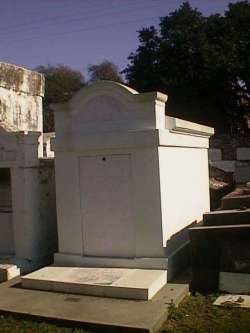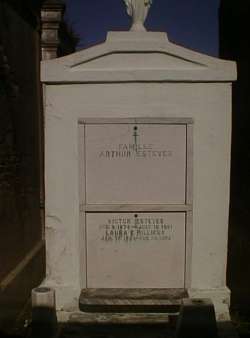African Americans in New Orleans:
Les Gens de Couleur Libres
Page 3
|
| In 1861, wealthy merchant and landowner Francois Lacroix brought suit before the Second Justice of the Peace against James L. Imlay for the recovery of $100 representing a year's rent for two lots of ground at Gentilly, near Bayou St. J
ohn, on which Imlay held a ten year lease. Lacroix had leased the land to Imlay in 1859 for the purpose of establishing and maintaining a race course on the property, in conjunction with additional adjacent land leased from Alphonse Miltenberger. We bel
ieve that this race course must have been the Union Race Course, later known as the Creole Race Course and, finally (and currently) the Fair Grounds. Originally laid out in 1852, the Union Course stood at the junction of Bayou and Gentilly roads. It cl
osed down after five years, but in 1859 the course was leased by the members of the Metairie Trotting and Pacing Club and renamed the Creole Course. During the Civil War, the course was leased by several promoters--among them, perhaps, James Imlay, who a
pparently did not carry out the terms of his lease. Shown here is an extract from a copy of the lease agreement, filed as evidence in the appeal of the Justice of the Peace's decision (for the plaintiff, Lacroix) heard in Third Dis
trict Court.
[Orleans Parish. Third District Court. #16506]
| The register of free people of color was created in response to the state law of 1830 designed to keep track of non-native Louisiana free people who entered the state after 1812 but before 1825 and other freed people who may have been nativ
es of the city and or state. Long established free families of color were not required to register since their roots in Louisiana went back before 1812. View a very interesting extract from Volume One of the Register.
[Office of the Mayor. Register of Free Persons of Color
Allowed to Remain in the State, 1840-1857.]
|

This 1842 city directory lists several free people of color by name and includes their addresses, but there are several other free people listed here who are not designated by either fwc or fmc.
|
| In 1841, the General Council of New Orleans passed an
ordinance establishing a Board of Health for the city. One of the
provisions of this ordinance also stipulated that the sextons of the
various cemeteries should record death certif icates presented to them and
send the information recorded to the Mayor at the end of the year for
retention in the archives of the city. The book provided to the mayor by
the sexton of the Catholic Cemeteries (i.e., St. Louis Nos. 1 and 2)
includes name s, origin, address, cause of death, race or color, age, and
the name of doctor who either attended them or other person giving the
information about the decedent. The abbreviation ?c.l.? (couleur libre) is
used to identify free people of color. In the St . Louis Cemetery No. 1,
opened in 1789, whites and free people of color are often buried side by
side and sometimes in the same tomb; in St. Louis No. 2, opened in 1823,
the square closest to Canal St. was set aside for free people of color and
slaves. View a transcription extracted from the
original record book for the Catholic Cemeteries. [Office of the Mayor. Records of Interments in the
Non-Municipal Cemeteries of New Orleans. v. 4, Catholic Cemeteries,
1841-1842]
| 
According to her tomb, Marie Justine Cirnaire, the widow Couvent, was a
"native d'Afrique" and approximately 80 years old when she died in 1837.
|

Throughout their history in Louisiana, free people of color were subjected to restrictive laws designed to limit their numbers in Louisiana. In the early years of the 19th century, the Territorial government passed legislation requiring that all free bla
cks carry proof of their freedom upon their persons. Seen here is such a document, belonging to William Carret, a young mulatto man about 18, who in 1854 satisfied the Second District Recorders Court that "he was a free born of the state of Louisiana." T
he pass entitled him "to pass and repass through the state unmolested, he demeaning well and properly." The tears in this document indicate that the paper was folded and refolded, perhaps carried for many years in a wallet or pocket.
[Official Vertical File]
|

The family tomb of the Rousseves, including Charles Rousseve, his ancestors, siblings, and descendants. Rousseve, a New Orleans educator and historian, came from a highly educated family which included a Catholic priest, a nun, teachers, a social worker,
and an architect.
| 
The tomb in St. Louis Cemetery No. 2 of Arthur Esteves and family. Esteves (d. 1908), was a sail and awning maker, a trustee of the Couvent School and the president of the Comite des Citoyens (Citizens Committee), a group of Creole early civil rig
hts activists who challenged the state?s Jim Crow laws. Esteves is pictured here in the original French edition of Rodolphe Desdunes? classic work Nos Hommes et Notre Histoire.
|





